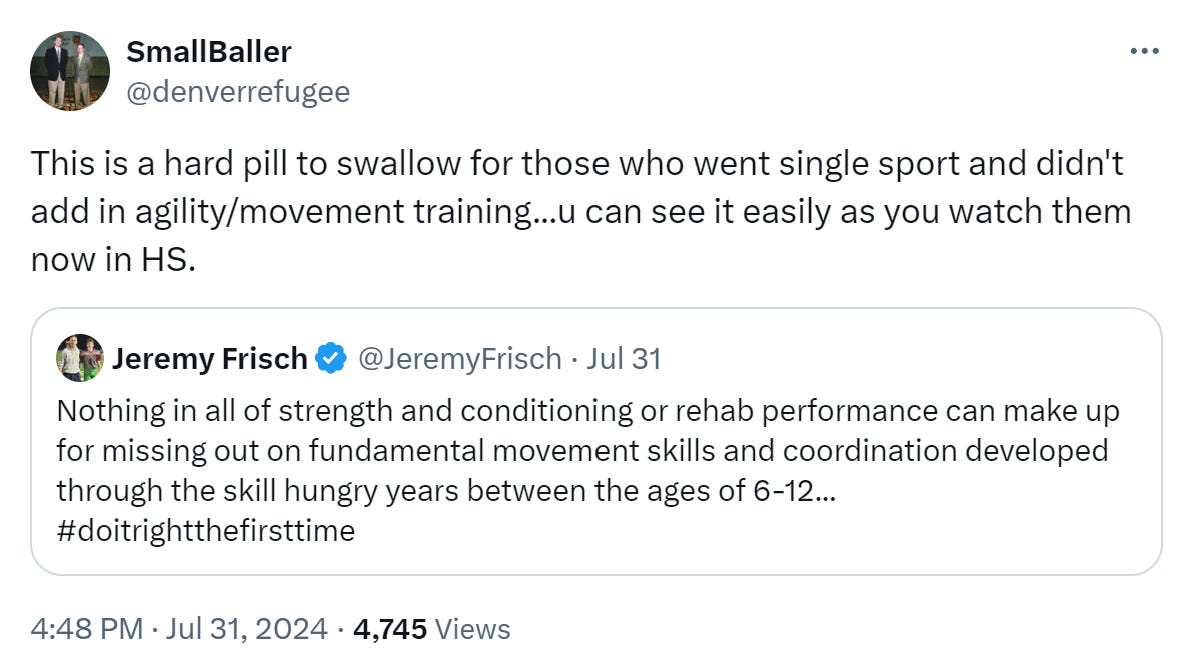Slammers Athletic Foundations 2024
Basic movement skills + movement competency. Why didn't we hear about these things as a kid? Because you didn't grow up with an iPad in your hands!
Our youth Athletic Foundations program for summer 2024 wrapped up this past Wednesday down South. The program is centered around the idea that movement competency for developing athletes creates adaptability and creativity in training and competition. Much of the curriculum for this program was built off of the philosophies of the Athletic Skills Model - the youth development model for AFC Ajax (a world-famous soccer club in the Netherlands). The goal of the program is to prepare our youth athletes for the field and for the weight-room in high school. If you are a parent and are interested in youth athlete development, this book is the best use of $40 that you could possibly come by. More or less, Athletic Foundations is that book applied.
There aren’t a whole lot of Americans doing this youth development thing right anymore…
Considering the low-quality of content on Twitter these days, let me help you with a few suggested follows. I would highly suggest following these accounts if you are interested in youth athlete development: Lee Taft, Jeremy Frisch, and Joe Eisenmann.
The Importance of Movement
Movement competency for developing athletes creates adaptability and creativity in training and competition. It is important to integrate a variety of basic movement skills into structured and unstructured activity, not just the movement skills needed for a specific sport. Developing athletes, especially early on, should be presented with activities that can build a diverse and complete movement skill portfolio. In doing so, the developing athlete will be well-positioned to specialize later on, if they choose to do so.
In a pre-iPad / tablet / video game / etc. world, movement competency came much easier as kids spent their free time outside playing self-organized games, climbing trees, rolling down hills, etc. In today’s world - for better or worse - parents simply need to be more deliberate about making sure that their kids are nourishing their movement development regularly.
The Ten Basic Movement Skills
The Athletic Skills Model (ASM) is a developmental methodology used by AFC Ajax, a soccer club in the Netherlands. The ASM breaks down movement into ten basic movement skills. A variety of structured and unstructured activities should be strategically and discreetly employed to tap into the development of all of the ten basic movement skills.
Check out some highlights from Athletic Foundations in the context of the ten basic movement skills:
Balancing and Falling
Balancing and falling are linked to all ten of the basic movement skills. In all movements we need to maintain and restore balance. When we become unbalanced, we fall. It is important to learn how to fall in a number of different ways so as to quicker regain balance and stability to continue activity.
Moving and Locomotion
Moving and locomotion is the act or power of moving from place to place. This skill involves forward, backward, and lateral movement as well as acceleration and deceleration.
Jumping and Landing
Jumping and landing involves flight, height, and rotation. Neuromuscular control is imperative for optimal alignment in jumping and landing.
Kicking, Shooting, and Aiming
Kicking, shooting, and aiming are representative of ball-handling skills with the lower half of the body. We didn’t get into a whole lot of lower-half ball-handling skills during our program.
Romping and Fighting
Use contact to push, pull and balance. Some form of contact mat or cushion should be employed. Most team sports contain some element of contact. Though important, we did not integrate any contact-activities into our program.
Climbing and Scrambling
Related ways of moving up, down, and sideways. Bear-crawl party - when the turf wasn’t too hot.
Swinging
Experienced by sitting or standing on a swing or swaying while hanging onto a horizontal bar. This is another one that we didn’t integrate for obvious reasons (access).
Throwing, Catching, Hitting and Aiming
Throwing, catching, hitting, and aiming are representative of ball-handling skills with the upper half of the body. This is a basic movement skill that was frequently integrated in a number of different ways - from catching tennis balls to wall ball.
Rolling, Tumbling and Turning
Rolling, tumbling, and turning involves rotating on different planes and axes including the longitudinal, latitudinal, and depth axes. You’d be shocked how few 8-12 year-olds can complete a somersault… This was a focus area throughout the program.
Music in Motion
Music in motion is all about response to varieties of rhythms. The music in motion basic movement skill can improve body and muscle control. Unfortunately, we don’t have any salsa dancers on staff to help with this one…
Baseball5
When numbers allowed, we played Baseball5 on Fridays. Often times, some of our college guys would come out and join in on the fun. Baseball5 is a fast-paced, high-repetition game that can be played anywhere with little equipment (just need a ball). To oversimplify, it’s a baseball-equivalent to what futsal is to soccer. If you’re interested in learning more about Baseball5, check out this blog.


